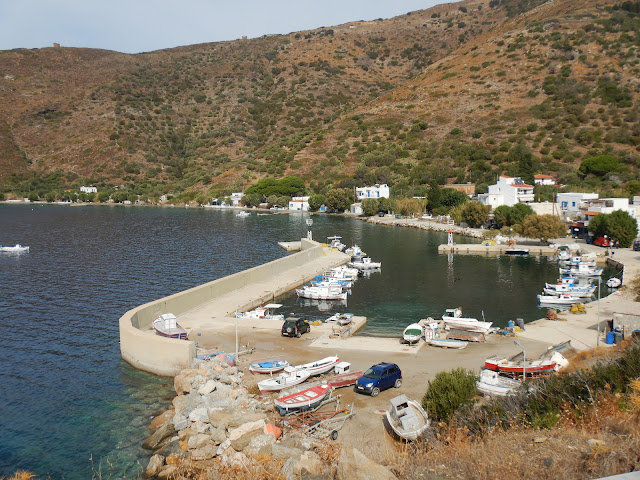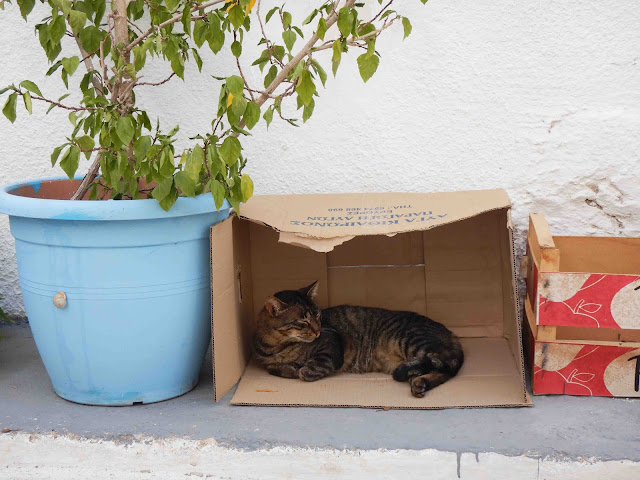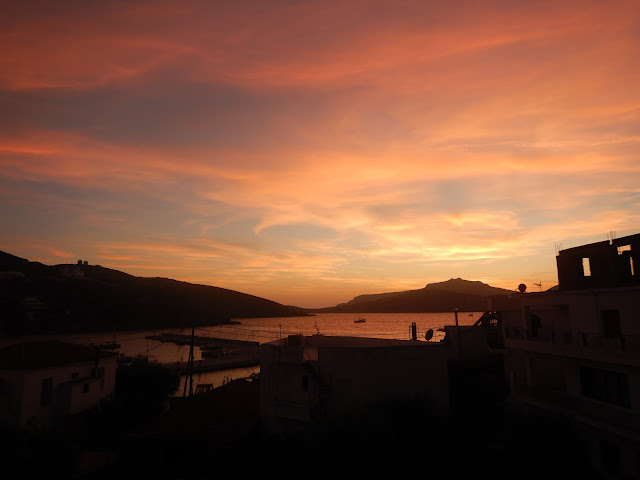Once upon a time, back in the days when mythical creatures like the Minotaur lived, a man called Daedalus and his son, Icarus, wanted to escape from where they were imprisoned by King Minos in Crete. Daedalus was a clever inventor and created wings from feathers and beeswax so they could fly away. He instructed his son not to fly too close to the sun as the heat would melt the beeswax and the wings would fall apart. Icarus was giddy with the delight of flying though and ignored his father's warnings. He flew too close to the sun and the wax melted. The feathers dropped off one by one and Icarus plunged into the sea and drowned. He devasted father collected his son's body and buried him on a nearby island. After this, the island was named Icaria (Ikaria).
A huge sculpture stands in tribute to the island's namesake at the port. It was lovely at sunrise.
Nearby was a more traditional take on the legend.
RED: A very long time after Icarus fell into the sea, after the second world war and at the end of the civil war, thousands of Greek communists were deported to Ikaria. They were free to move around the island but they couldn't leave. Locals were told not to interact with them but Greek hospitality is hard to restrain and soon the communists and locals were all mingling together. For decades, the island became known as 'the red island". There is still a strong communist undercurrent here and we often see graffiti about it.
GREEN: Ikaria today is an astonishing island with beautiful beaches, high mountains and - wait for it - forests! Yes, Ikaria is one of the rare 'green' islands we've visited. It's so wonderful to see after the aridness of most other Greek islands.

BLUE: We had never heard the term "blue zone" until we came here. Apparently a blue zone is an area where people live a long time. There are only five in the world and Ikaria is one of them. There is much conjecture about why people apparently live such long lives here. Some say it's because of the local honey where bees harvest the sap of the pine trees. Others say it's the special wine that's somehow made in a different way. We may never know but many people seem to come here to try to learn the secrets of longevity. I don't think it's too hard to work out though. Everyone is so laid back in Greece. The low stress levels must surely contribute to longevity. The way people catch up with each other in cafes every morning is surely important too. Social interaction is part of who we are and has been proven to help health. I think all of Greece should be a blue zone!
We had a tiny, but good apartment in the port town of Agios Kirykos. We were central to everything and the balcony had views to the sea, the town and the mountains. The loo in this one certainly didn't have a view though. The bathroom was so narrow that our heads almost hit the wall when we sat down!
Our host was a lovely lady with a big challenge in life. She was only in her 30's or 40's but got cancer on her face somewhere. Most of the right side of her face had been surgically removed. Some bone from her leg had been grafted to form a cheekbone of sorts and skin from her calf was also grafted. Her eye sagged, half her teeth were missing and the skin graft was a very different colour to the rest of her face. It was a shocking job and looked like a butcher had attacked her face but perhaps that's the best they could do. Kudos to her though, she carried on as if nothing had changed. Her English was good so she spoke freely to us but she had trouble pronouncing words properly. It was a good lesson on how we can carry on when life deals us a bad hand.
From our balcony we saw gorgeous sunsets.
If we walked down to the port we could also see the sun rise behind the Fourni Islands, our next destination.
There are so many cats on this island. Some are super cute though. There were always some playing on the stairs near our apartment.
We met some fun people here - a woman from South Africa and her Australian husband plus two ladies from Germany. They were all staying at Thermae, the next village up, and we often caught up at coffee time in the mornings. When the South African married the Australian she moved to Australia and had some very funny stories to tell about the cultural differences between the two countries. The first time she was invited somewhere and was asked to bring a plate she also brought a knife, fork, spoon and bowl just in case! Another time she was invited for 'tea' so she turned up at 3pm thinking it was afternoon tea. Interestingly, she struggled with the lack of security in Australia compared to South Africa and felt very unsafe in a house with no security fence or barred windows.
We had one very big night with this group at a restaurant in Thermae. John bought a drink for a Singaporean couple at the next table and they ended up joining us. At the end of the night it was a 20 minute walk home at 1am which was challenging at the time!
Thermae is one of many places around the island that has hot thermal pools. These pools are described as being 'radioactive' due to the radon content. Many people come to Ikaria to use these pools, which are usually just warm patches in the sea. They're supposed to help with certain ailments. I had to seriously wonder though if this was a safe thing to do. From what I could gather though, it is, so we tried it one day.
I had found a nice spot further up the coast. As we approached the edge of the sea, I could see steam rising up in places. The rocks were red and green (those colours again!) from the copper and minerals
It was weird bobbing around in the water with cool water coming from the sea side and hot water coming from the shore. We could move around to choose warmer or cooler spots but there was always enough fluctuation in the movement of the water to ensure that sometimes we were hot then cold then hot then cold...
A Greek and Russian couple from Athens were there too and they were very interesting to talk to. We discussed history and politics and all sorts of things - or at least they discussed them with us. We couldn't get a word in edge-wise! As interesting as they were, they were also very intense. We have found that, as much as we love the Greek people, they are generally terrible listeners.
We had some amazing walks and bike rides here. I walked to the top of a hill where a gorgeous church provided spectacular views.
One half of the 360 degree views.
Another time I walked at one end of the island where an ancient tower stood over the ruins of the fortress of Drakanos. Built in the 5th century BC, apparently the tower stood intact for over 2,000 years until an admiral passing by a couple of hundred years ago thought it would be a good target to test his cannons on! Today the restored tower dominates the rocky headland.
After noticing the lack of thyme on the last island or two, I was delighted to smell its wonderful scent again here. Yes, those brown, shrivelled up plants are thyme.
Following a marked trail, I then crossed a small ravine on a rough track until I was at the next headland. In front of me was a cave where Dionysius, the Greek god of wine and pleasure, was apparently born. Another account though says that this was Dionysius's lair where he drank and cavorted with nymphs. I much prefer the second version! Looking at the steep slope of the cave floor though, I can't really see that anyone would party here or chose to give birth here! To give you a sense of scale, I've put a pink arrow in the bottom left corner to point out a goat!
Just past the cave was a gorgeous beach which was completely empty at this time of year.
Meanwhile John was slogging up and down mountains on his bike. He went much higher than me and was sometimes up in the clouds.
John and I met for lunch at this gorgeous restaurant on the beach. We love these places at this time of year but they'd be so busy in August.
Thanks to our friends from Thermae, we heard there was documentary festival on so we went to see it. The film we saw was good but the feature image for the movie was the same memorial that John had just taken a photo of! These memorials are common and are dedicated to someone who has died.
Ikaria is a large island so we rented a car to explore it. Much to our amazement, it took us 1.5 hours to go 40 kms! The roads are really twisty and some are rough but the views were spectacular!
Ikaria was yet another island that was raided by pirates in the past. The solution at the time was to build houses in places that couldn't be seen from the sea. They also built the houses out of natural materials so they blended in with the environment. Slate rooves looked wonderful with old local stones. Often the rooves only sloped to one side. Many buildings were just left as ruins, like this one was, or were used as farm sheds.
This one had been renovated. I love the chimney!
We explored an area called the Raches (Hillsides). Being at a higher altitude it had a cooler climate and, with relatively fertile soil, it was lush and green and was dotted with beautiful stone houses. Christos Raches was the largest village. We walked into the main square and were blown away by how incredibly beautiful it was. Gorgeous stone buildings surrounded the central area. Balconies hung over the street and huge plane trees just starting to get their autumn colours provided the finishing touches to the scene. It looked like we had stepped into a French village, not a Greek one!
We loved this area so much that we decided to come back for a couple of days. We found a lovely apartment (sadly, not in an old stone house) and had a wonderful stay here.
The walks in the Raches area were amazing! There are many signposted walks around this island although I found that some trails were marked better than others. My first one was a bit of adventure. John dropped me off and headed out on his bike. I found the start of the trail which, to my astonishment, dropped steeply down from the main road. A few minutes down the hill I found this sign.
Umm, okay! It was only 10am so I ventured on. The walk was steep and scary but it was stunning! I climbed carefully down the rocky path that descended down the side of a gorge. All around me was lush and green, so different from everywhere else we'd been. Huge rocks fractured into squares and rectangular shapes - so unusual for rocks!

For nearly an hour and a half I slowly climbed down the gorge. I began to get concerned as I knew it was supposed to take a lot less time than this. I began to assess my options. If I kept going I had no idea if the track would improve or remain as difficult as it had been so far. Tired and hot, I came to a signposted junction, seemingly in the middle of nowhere.
The trail on the top sign was the one I'd been following, I certainly didn't want the bottom one. But what was the sign to left pointing to? The track wasn't on my map apps and the sign was faded. It took me a good ten minutes of studying the sign and my apps to workout that the sign pointed to a mountain that was more in the direction of where I wanted to go. I decided to take that track. After a steep scrambly climb up it leveled out to a more gentle climb and led me exactly where I needed to go. Phew!
One day a did a longer walk right around the Raches villages. I didn't always find the marked tracks but it was beautiful! Tiny pink cyclamen popped their heads up through the autumn leaves.
One of my favourite spots was an old watermill. The track down to it led through beautiful forest. I crossed a number of small creeks with cute bridges made of stone and covered in autumn leaves.
The watermill was like something out of a fairytale. The old stone building was covered in vines.
Inside, the working parts were still all there. Water from the river was funnelled through a small dam and drains to a place where the water turned a small turbine to crush the wheat. This mill last operated in the 1960's which is later than any other mill in the area.
One of the occasional dangers of walking in Greece, or anywhere really, is that there are sometimes over-protective dogs. I was always on the lookout for dogs but I wasn't expecting my path to be blocked by an enormous billy goat! It took a while for me to summon up the courage to squeeze past him but he was actually quite friendly.
At times, the track was pretty overgrown. This was my path for a while!
Colourful bee boxes were stacked up outside a honey farm.
I finally finished the walk near some balancing rocks. It was a great day!
We found a wonderful little restaurant with a handful of tables under some gorgeous shady trees. The night were cooler in the mountains so we had jackets on, but it would have been a lovely place on a hot summer night. We met an English/Bulgarian couple there plus a Czech guy who was a unique character. He was a big man with a large bushy beard to match. He travelled a lot and could speak a number of languages. He loved to tell stories. His funniest story was about the toilets in Japan which are famous for having buttons that do all sorts of things.. He tried to flush one once but, even though he could hear flushing sounds, nothing was happening. He later learned that the button he was pressing was for making fake flushing noises to drown out fart noises!
Greeks are masters of ingenuity. I love the way they just do whatever is needed to make things work. They are the practical people, the ones who fix things with whatever is on hand. Gates are hinged to posts with rope, thorny branches keep goats out and bits of old tin will patch a fence as good as any bought option. The results are often pretty unattractive but I understand the reasoning behind them. All through this area were poly pipes transporting water from the springs and dams to gardens and farms. Sometimes these pipes ran a long way. At odd intervals, a metal pipe would stick up from an underground water system and every man and his dog would run poly pipes off the stand.
This one was a classic.
Not far away was a dam that was used to run hydro power. Three small and old wind turbines nearby were probably used to pump water to the dams, a great way to use wind power! John rode to the dam and was gobsmacked by the sign that was there. The setup cost 50,000,000 euros and it was tiny! It would never make enough electricity to power the island.
We would love to have spent more time in the Raches area. It was so beautiful and there were so many trails to explore.
We returned back to Agios Kirykos, on the south side of the island. Out on the trails again the next day, my last walk in Ikaria took me along the spine of the island. I slogged up a loooong steep hill. The first part was through forest where I was fascinated by a stunning old stone wall. Large pieces of slate were anchored to the top of the wall (with more stones) in such a way that they leant outwards, keeping goats out, or at least they would have if it had been maintained.
In some places, pieces of slate two to three metres high were built into the wall.
The forest stopped and the rest of the climb was through rocky scrub in the hot sun. I finally reached the castle that was my target at the top only to find it was no more than a few piles of rocks. Oh well. At least the views were amazing! I looked across to other islands with a layer of clouds beneath me.
We finished our stay here with a wonderful meal at a restaurant in a nearby village where we ate too much good food while overlooking the sea. It was a perfect end to a wonderful visit!
Til next time.
Heather and John


































































